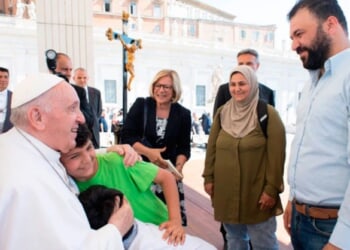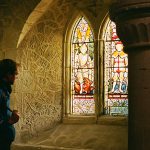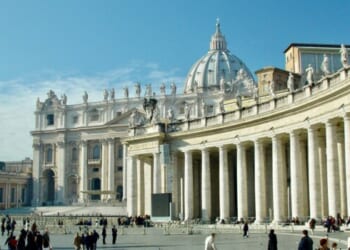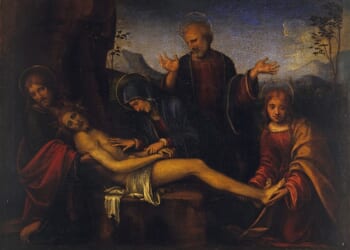At the time of writing, the Catholic world is still basking in the afterglow of the election of our new Holy Father, Robert Francis Prevost as Pope Leo XIV. The election of the new pontiff brought a renewed interest in the institution of the papal conclave, the millennium-old custom by which popes are selected from among the cardinals of the Catholic Church. The opening ceremonies of the 2025 conclave were watched by millions worldwide—the procession of the cardinals into the Sistine Chapel, the singing of the Veni creator spiritus, and oaths sworn by each cardinal—in Latin—to obey the rules of the conclave and to faithfully discharge the papal office, if elected.
For Catholics today, the Sistine Chapel is iconic as the location where the conclave is held. So identified is this famed chapel with papal elections that it is difficult to think of a conclave happening elsewhere. Yet such was not always the case. In fact, holding conclaves in the Sistine Chapel is a custom of relatively recent origin. It was only with the conclave of 1878 that the custom began of electing the pope in the Sistine Chapel. In this article, we shall briefly explore where conclaves were held before this, and why the cardinals of 1878 settled on the Sistine Chapel.
The history of papal conclaves can be roughly divided into four periods: from 1061 to the Renaissance, from the Renaissance to the French Revolution, from the Revolution until unification of Italy in 1870, and from 1870 to today. We shall consider each in turn.
Papal conclaves in the modern sense began in 1061 with the election of Alexander II, the first pope to be elected by the College of Cardinals under the prescriptions codified by Nicholas II in his 1059 bull In nomine Domini, which established the papal conclave as a means of wrestling control of the papacy away from the Holy Roman Emperors. Between 1061 and the Renaissance, papal conclaves were ad hoc affairs held wherever it was most convenient for the cardinals to assemble. This was, of course, usually in Rome, but all different venues within Rome were utilized, including John Lateran, Santa Maria sopra Minerva, and old St. Peter’s Basilica. Because the popes once ruled vast swaths of central Italy as political monarchs of the Papal States, other Italian cities such as Bologna and Perugia sometimes hosted conclaves. Occasionally, popes were even elected outside of Italy altogether. Callixtus II, for example, was elected in Cluny Abbey in France in the conclave of 1119, while John XXII was elected in the Carpentras Cathedral in Lyons in 1314. Martin V was selected at Konstanz Minster in Germany in 1417 in the election which ended the Western Schism. Five popes of the 14th century were elected in the Palais des Papes in Avignon, France.
During the Renaissance, we see that the cardinals seem to settle on the Apostolic Palace as the location for papal conclaves. The history of the Apostolic Palace is long and complex, dating back to the 5th century when it was constructed as an alternative papal residence to the Lateran Palace. The old Apostolic Palace was destroyed by fire in 1361, prompting a century of renovations that culminated in the completion of a new structure by Eugene III in 1447. The restored palace was a marvel of Renaissance architecture, eminently suitable for an occasion as solemn as the papal conclave. The first conclave was held at the Apostolic Palace in 1455, which brought Callixtus III to the chair of St. Peter. From 1455 until the French Revolution, every subsequent papal conclave would be held in the Apostolic Palace.
Even so, at 1.7 million square feet, the Apostolic Palace is a huge venue, more of an entire complex of buildings than a single structure. Conclaves took place at differing chapels within the Apostolic Palace complex. Leo X, for example, was elected in Niccoline Chapel in 1513 while Pius IV was selected in the Cappella Paolina in 1559. Incidentally, it is during this time that we see the first conclave held in the Sistine Chapel as well, in the 1492 conclave that elected the notoriously dissolute Alexander VI.
The conclave of 1774, which elected Pius VI, was the last before the outbreak of the French Revolution in 1789. This event brings us to our third period of conclave history, a time of considerable disruption for the city of Rome. The capture of Rome by the armies of the French Republic in 1798 made it impossible to hold conclaves at the Apostolic Palace, and the following conclave of 1800 was held in Venice, which elevated Pius VII to the papacy, the pontiff who would prove the implacable foe of Napoleon Bonaparte.
The first conclave after the end of the Napoleonic Wars was that of 1823. By this time, it had been almost fifty years since a conclave was held in Rome, and the cardinal electors opted to select a new location, the Quirinal Palace. The Quirinal—so named from its location on the tallest of Rome’s seven hills—was built during the Renaissance as the papal summer residence, its location high above Rome, making it an ideal repose from the humidity and stench of the Tiber. The first conclave at the Quirinal elected Leo XII and established what became a precedent for the post-Revolutionary popes. The conclaves of 1829, 1830, and 1846 were all subsequently held in the Quirinal Palace.
The conclave of 1846 brought Blessed Pius IX to the Chair of St. Peter. Pius’s long pontificate of thirty-one years would see calamitous times for the papacy, as the atheistic Italian nationalists seized Rome in 1870 as part of the Italian Unification, dispossessing the papacy of the Papal States that it had ruled for a millennium. The Quirinal, too, was seized by the Italian nationalists who, in a deliberate slight to the pope, made the Quirinal the new home of the Italian monarch. The revolutionaries left only the tiny enclave of the Vatican under papal control.
When Pius IX died in 1878, it was therefore impossible to hold the conclave at the Quirinal. The cardinals then returned to the Apostolic Palace, this time choosing the Sistine Chapel for the site of the conclave. This first modern conclave in the Sistine Chapel resulted in the election of Pope Leo XIII, after whom our current pontiff chose his name. From 1878 to today, papal conclaves have continued in this tradition of selecting the new pope in the Sistine Chapel.
There is, thus, a splendid harmony in the accession of our new Pope Leo, whose election in the Sistine Chapel mirrors the election of the previous Leo. May our new Leo possess the same strength, insight, and holiness as his illustrious predecessor, the first of the modern popes elected in the Sistine Chapel.
Photo by Vlad Namashko on Unsplash














